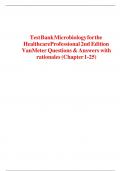Test Bank Microbiology for the
zx zx zx zx
HealthcareProfessional 2nd Edition
zx xz zx zx
zx VanMeter Questions & Answers with
zx zx zx zx
rationales (Chapter 1-25)
zx zx zx
,Chapter 01: Scope of Microbiology
zx zx zx zx
VanMeter: Microbiology for the Healthcare Professional, 2nd Edition
zx zx zx zx zx zx zx
MULTIPLE CHOICE zx
1. In the sixteenth century a father-and-son team, by the name of
zx zx , produced
zx zx zx zx zx zx zx zx zx
acompound microscope consisting of a simple tube with lenses at each end.
zx xz zx zx zx zx zx zx zx zx zx zx zx
a. van Leeuwenhoek zx
b. Semmelweis
c. Janssen
d. Hooke
ANS: z x C REF: p. 3 zx zx
2. “Animalcules” were first described by zx zx zx zx
a. Robert Hooke. zx
b. Antony van Leeuwenhoek. zx zx
c. Hans Janssen. zx
d. John Needham. zx
ANS: z x B REF: p. 3 zx zx
3. Micrographia, a publication illustrating insects, sponges, as well as plant cells, was
zx zx zx zx zx zx zx zx zx zx zx
zx publishedby xz
a. Robert Hooke. zx
b. Antony van Leeuwenhoek. zx zx
c. Hans Janssen. zx
d. John Needham. zx
ANS: z x A REF: p. 3 zx zx
4. Low-power microscopes designed for observing fairly large objects such as insects or
zx zx zx zx zx zx zx zx zx zx zx
zx wormsare xz
a. electron microscopes. zx
b. dark-field microscopes. zx
c. fluorescence microscopes. zx
d. stereomicroscopes.
ANS: z x D REF: p. 5 zx zx
5. A zx microscope that provides a three-dimensional image of a specimen is a
zx zx zx zx zx zx zx zx zx zx
a. dark-field microscope. zx
b. transmission electron microscope. zx zx
c. bright-field microscope. zx
d. scanning electron microscope. zx zx
ANS: z x D REF: p. 7 zx zx
6. The tool of choice to observe living microorganisms is the
zx zx zx zx zx zx zx zx zx
a. bright-field microscope. zx
b. phase-contrast microscope. zx
, c. fluorescence microscope. zx
d. electron microscope. zx
ANS: z x B REF: p. 6 zx zx
7. Which scientist is most responsible for ending the controversy about spontaneous generation?
zx zx zx zx zx zx zx zx zx zx zx
a. John Needham zx
b. Joseph Lister zx
c. Louis Pasteur zx
d. Robert Koch zx
ANS: z x C REF: p. 8 zx zx
8. Fossils of prokaryotes go back
zx zx zx zx billion years. zx
a. 4.0 to 5.0 zx zx
b. 3.5 to 4.0
zx zx z x zx zx
c. 2.5 to 3.0 zx zx
d. 2.2 to 2.7
zx zx z x zx zx
ANS: z x B REF: p. 9 zx zx
9. Molds belong to which of the following groups of eukaryotic organisms?
zx zx zx zx zx zx zx zx zx zx
a. Protozoans
b. Archaea
c. Fungi
d. Algae
ANS: z x C REF: p. 11 zx zx
10. The correct descending order of taxonomic categories is
zx zx zx zx zx zx zx
a. species, domain, phylum, kingdom, order, division, class, genus.
zx zx zx zx zx zx zx
b. domain, kingdom, phylum, class, family, order, genus, species.
zx zx zx zx zx zx zx
c. domain, kingdom, phylum, class, order, family, genus, species.
zx zx zx zx zx zx zx
d. kingdom, domain, phylum, order, class, family, genus, species.
zx zx zx zx zx zx zx
ANS: z x C REF: p. 10 zx zx
11. Complex communities of microorganisms on surfaces are called
zx zx zx zx zx zx zx
a. colonies.
b. biofilms.
c. biospheres.
d. flora.
ANS: z x B REF: p. 12 zx zx
12. A relationship between organisms in which the waste product of one provides nutrients
zx zx zx zx zx zx zx zx zx zx zx zx
foranother is called
zx xz zx zx
a. mutualism.
b. competition.
c. synergism.
d. commensalism.
ANS: z x D REF: z x p. 12zx
, 13. Which of the following sites of the human body does not have a normal flora?
zx zx zx zx zx zx zx zx zx zx zx zx zx zx
a. Intestine
b. Skin
c. Vagina
d. Blood
ANS: z x D REF: p. 12 zx zx
14. Which of the following lack nucleic acids?
zx zx zx zx zx zx
a. Archaea
b. Viruses
c. Prions
d. Bacteria
ANS: z x C REF: p. 11 zx zx
15. The binominal system of nomenclature was originally developed by
zx zx zx zx zx zx zx zx
a. Pasteur.
b. Linnaeus.
c. Martini.
d. Jenner.
ANS: z x B REF: p. 11 zx zx
16. Which of the following scientists performed the first vaccination against smallpox?
zx zx zx zx zx zx zx zx zx zx
a. Pasteur
b. Jenner
c. Semmelweis
d. Koch
ANS: z x B REF: p. 9 zx zx
17. Which of the following diseases is generally caused by contaminated food?
zx zx zx zx zx zx zx zx zx zx
a. Mumps
b. Shigellosis
c. Legionellosis
d. Tuberculosis
ANS: z x B REF: p. 13 zx zx
18. Which of the following diseases is transmitted via aerosols?
zx zx zx zx zx zx zx zx
a. Psittacosis
b. Shigellosis
c. Leptospirosis
d. Giardiasis
ANS: z x A REF: p. 14 zx zx
19. Which of the following organisms is used in the production of cheese?
zx zx zx zx zx zx zx zx zx zx zx
a. Propionibacterium shermanii zx
b. Acetobacter aceti zx
c. Giardia




